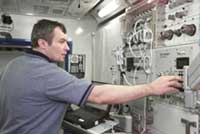Effects of EVA and Long-Term Exposure to Microgravity on Pulmonary Function (PuFF): Results to date
|
Results
In progress.
Results
from previous studies have shown that the lungs are profoundly affected
in space. Gravity causes blood to move primarily through the bottom
portion of the lungs and the weight of the rib cage affects the shape
of the lungs. Without the pull of gravity, the lungs reshape slightly
and blood flows through them differently. Furthermore, chest muscles
that help pump the lungs begin to atrophy in the weightlessness of low
Earth orbit. The ISS crew, who may perform multiple EVAs during
their stay, provide a excellent opportunity to study the cumulative effects
of decompression on the pulmonary system. Additional tests conducted
on the ISS will allow researchers to determine how long-duration space
flight further alters pulmonary function.
Applications
Gravity
tends to distort the lung’s anatomy and exaggerate lung disorders. Removing
the stresses of gravity provides unique insight into lung performance.
Puff will not only provide data that helps researchers understand fundamental
pulmonary physiology, but will also provide data that shows the effects
of decompression and contaminants from closed air systems on lung performance.
Thorough testing under challenging microgravity conditions is the first
step toward developing countermeasures that will protect crews during
long-duration space flight. The countermeasures designed for human
space exploration can also be applied to similar conditions on Earth (variable
air pressure and closed-loop environments), such as on high-altitude aircraft
or submarines.
Related Publications
J.B. West. 2000. Physiology in microgravity. J. Appl. Physiol. 89: 379-384.
J.B. West and G.K. Prisk. 1999. Chest volume and shape and intrapleural pressure in microgravity [letter]. J. Appl. Physiol. 87: 1240.









